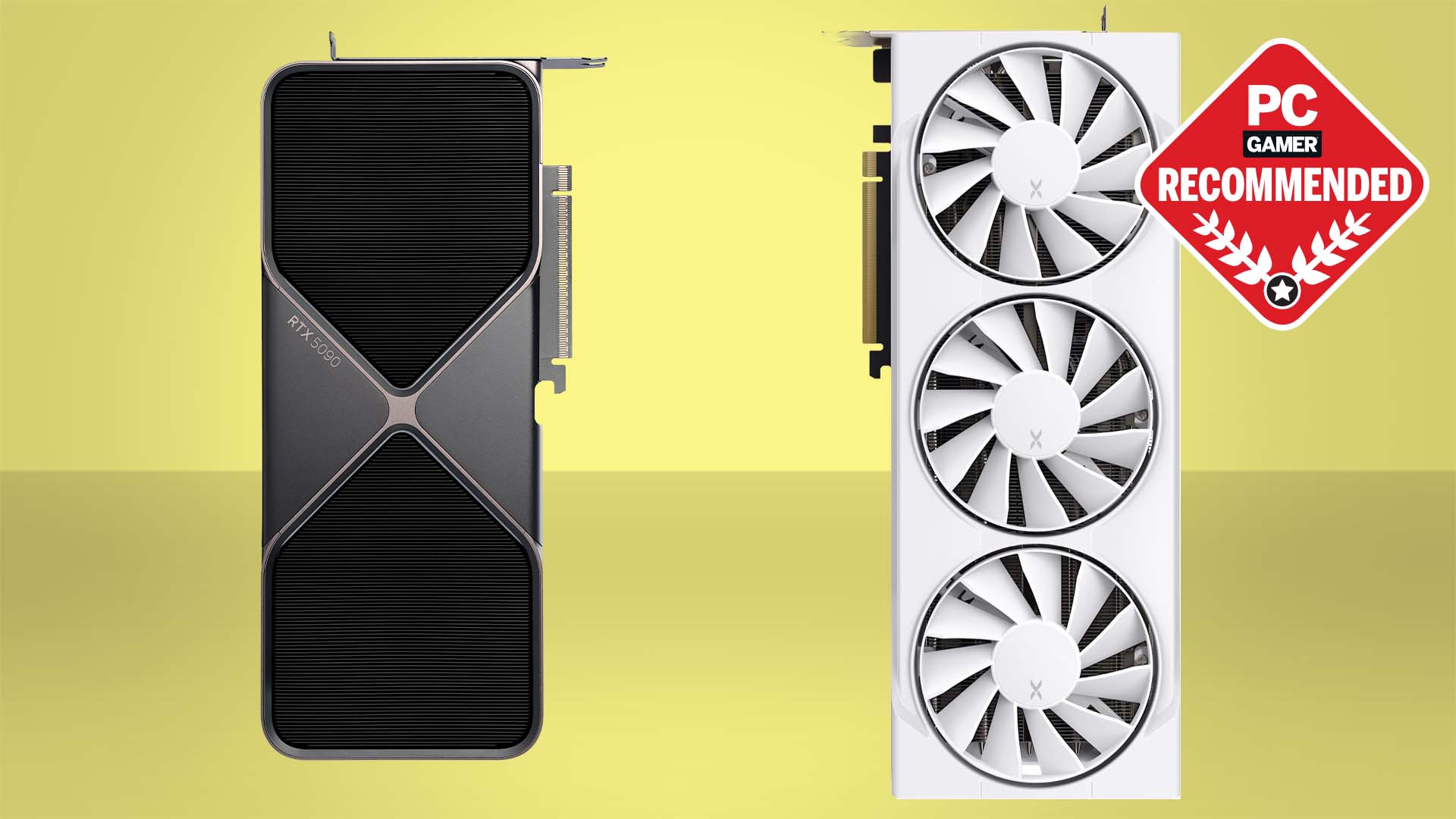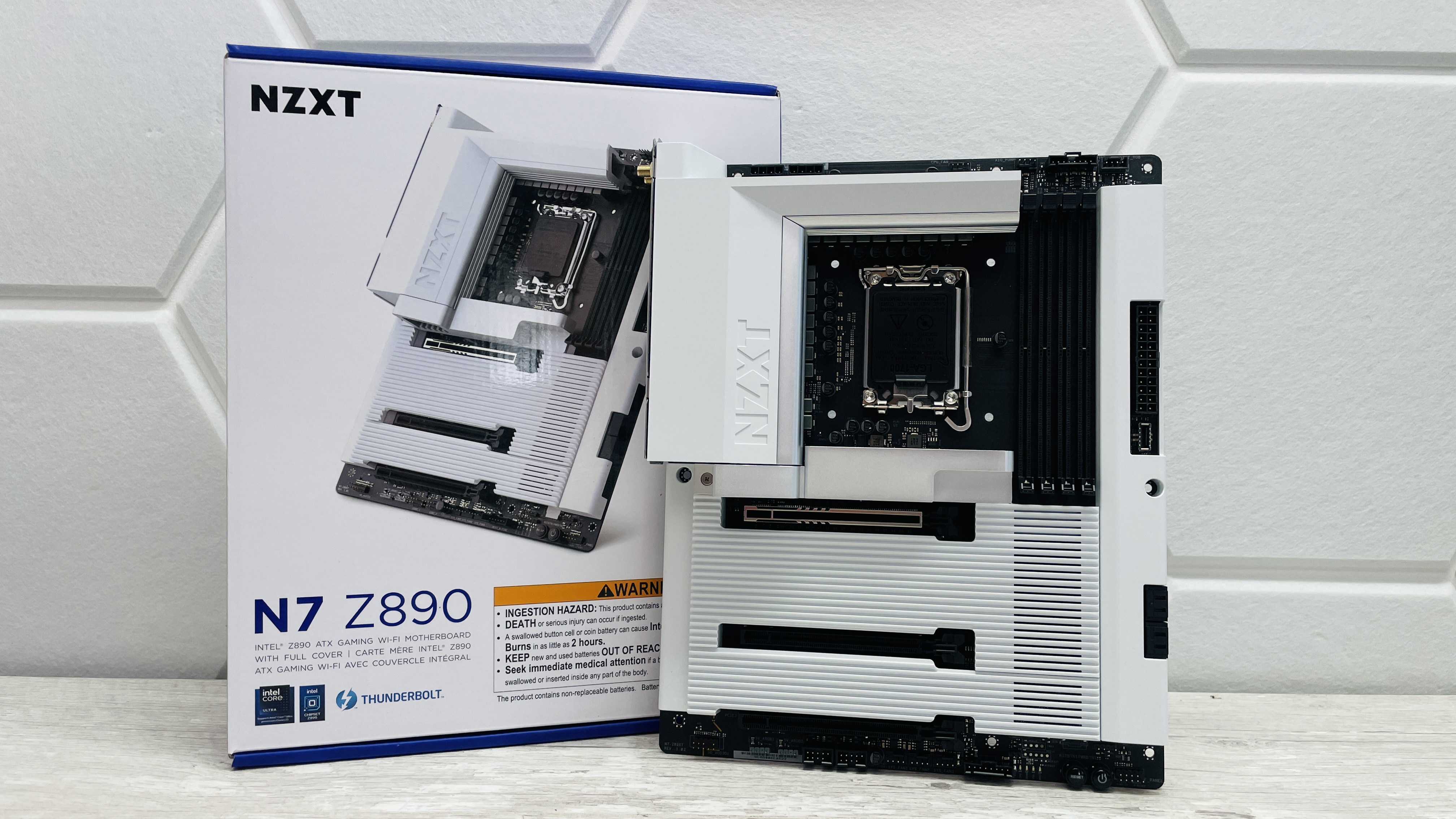AMD Radeon Pro Duo arrives at last, sort of
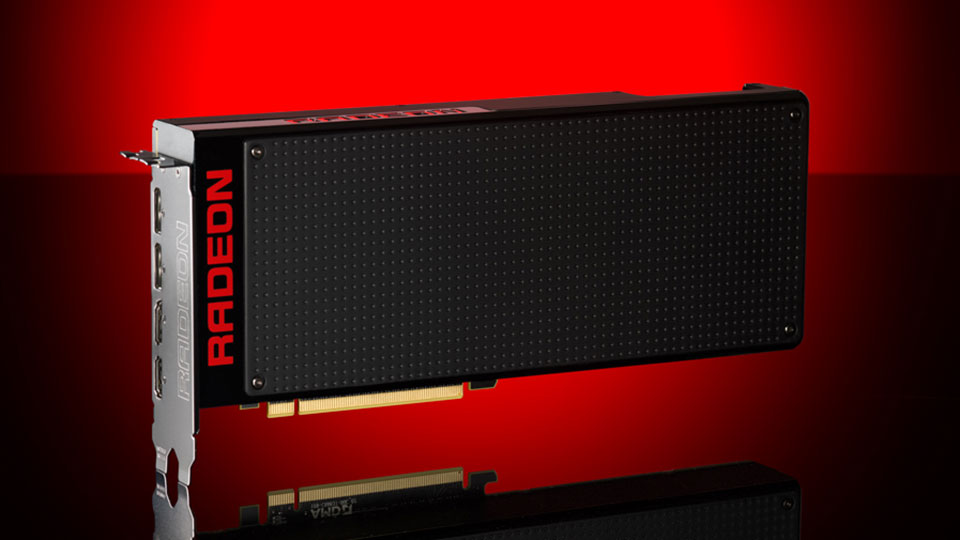
Better late than never
When AMD showed off the new Fiji GPUs last year, they talked about four products: R9 Fury X, (vanilla) R9 Fury, (miniature) R9 Nano, and a dual-GPU card that was eventually christened the Radeon Pro Duo. The first card showed up in June, followed by the Fury in August and the Nano in September. By all rights, the Pro Duo should have launched not long after the Nano, but that never happened, and the longer we waited, the more we wondered what was going on with the dual-GPU halo card. Today is the official launch of AMD's Radeon Pro Duo, but it feels more than a little stillborn.
AMD informed us last week that they're not sampling the Radeon Pro Duo to reviewers—or at least, not "traditional" reviewers. We'll get to that in a moment, but all we have to go on right now are product images and a slide deck, the latter of which includes some benchmarks and a spec sheet. So we're not reviewing the Pro Duo as such, but that doesn't mean we don't have plenty to discuss. You see, the Pro Duo is effectively CrossFire R9 Nano, on a single PCB, so armed with a couple of R9 Nano cards we're able to get a pretty clear idea of how the Pro Duo would perform.
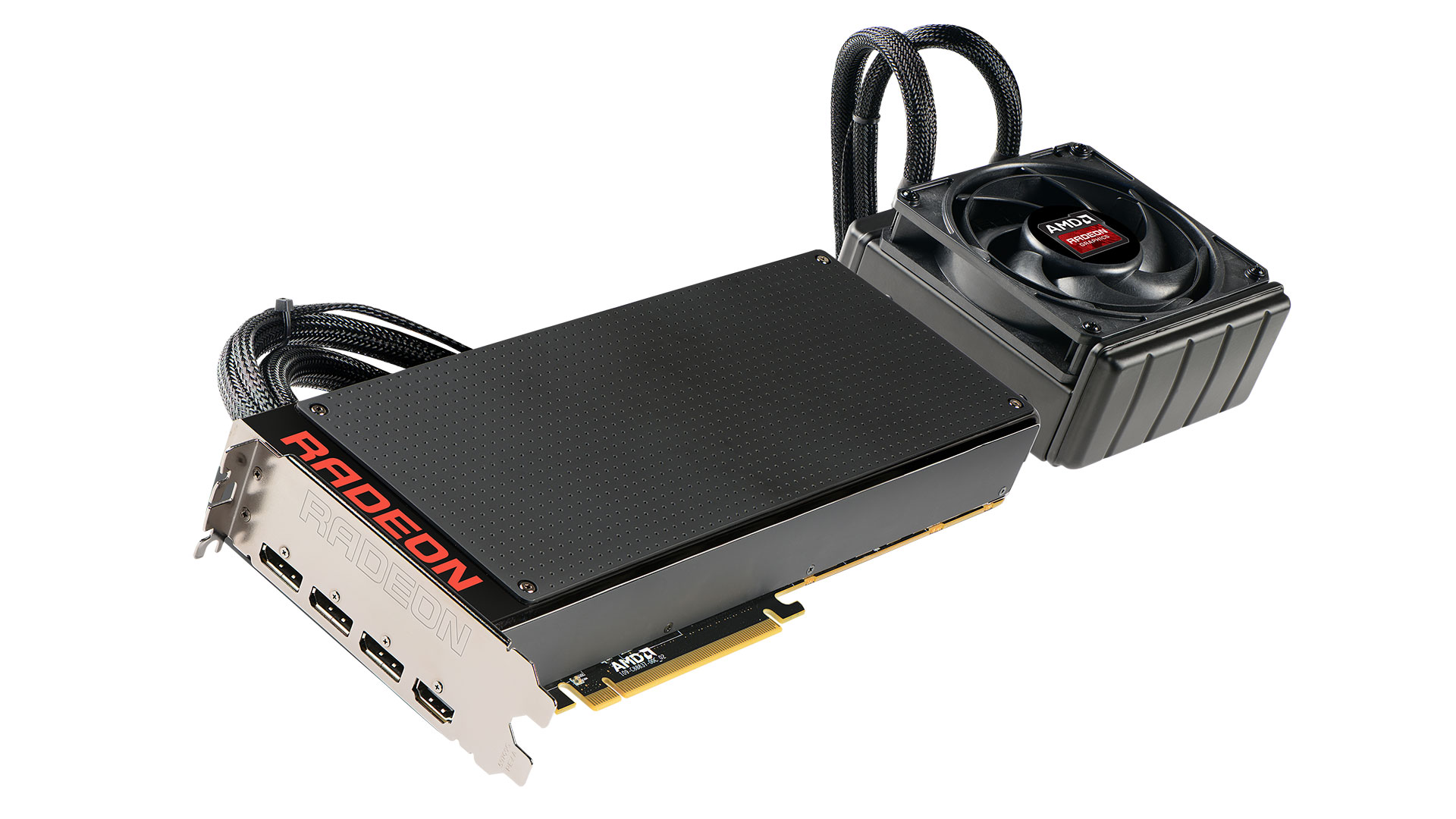
Dual-GPU cards have always been a niche market, and the Pro Duo takes that to a new level. The last dual-GPU card from AMD, the R9 295X2, was roughly equivalent to CrossFire R9 290X (with lowered clocks unless you overclocked), and it was priced at $1499, compared to $549 for individual 290X cards. It also launched six months after those cards, and the market was still languishing in 28nm land. Radeon Pro Duo targets that same price, $1499, but this time the R9 Nano has already dropped to $499. Perhaps more problematic is that we're nine months after the Fury X, but we're also about two months before the 14nm FinFET Polaris parts are rumored to arrive.
And that, in a nutshell, is why AMD isn't sampling the card to reviewers—they can guess what we would say: "too little, too late, and too expensive." They're pretty much right. Other than occupying a single slot and using a single closed loop liquid cooler, it's not any faster than a pair of R9 Nano cards. But AMD is throwing a bit of a curve ball here as they're touting this as a professional card rather than just a gaming monster.
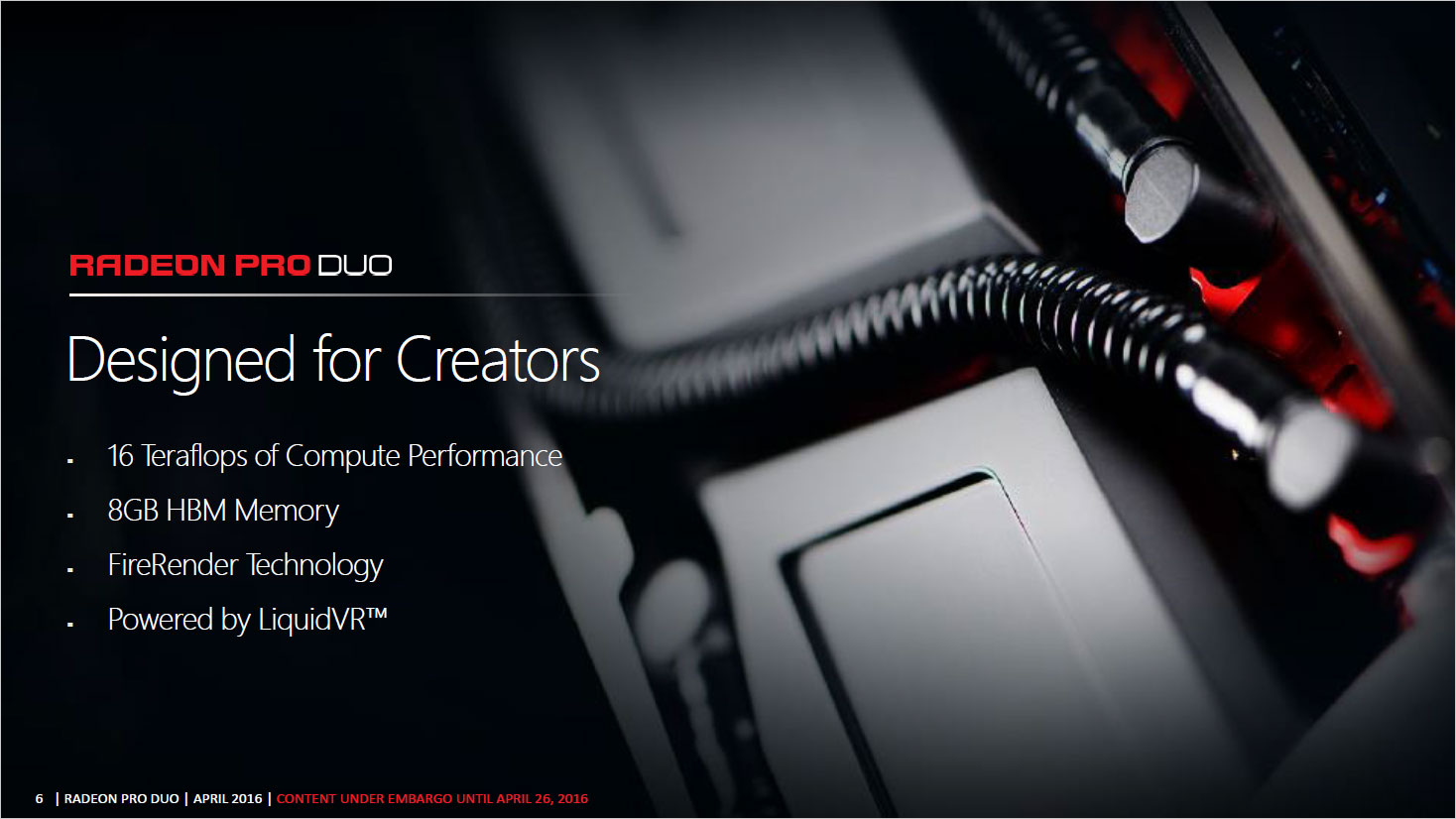
The marketing is all about content creation, TFLOPS, LiquidVR, and DX12; and the Pro Duo should do well in all those areas. To further muddy the waters, it appears AMD will also give owners of the Pro Duo a choice between gamer and professional drivers, so in a sense this is a workstation class card. This is AMD's first VR Ready Creator offering as well, and AMD is partnering up with Crytek and their VR First initiative to help budding VR developers. If you're willing to pay the price premium for a dual-GPU card and you need the specific features that AMD is offering, it might be worth the price premium.
What if you're just a gamer?
Intel Core i7-5930K @ 4.2GHz
Gigabyte GA-X99-UD4
AMD R9 Nano (Reference)
Nvidia GTX 980 Ti (Reference)
Samsung 850 EVO 2TB
EVGA SuperNOVA 1300 G2
G.Skill Ripjaws 16GB DDR4-2666
Cooler Master Nepton 280L
Cooler Master CM Storm Trooper
Windows 10 Pro 64-bit
AMD Crimson 16.4.2 Hotfix
Nvidia 364.72
While we don't have an actual Radeon Pro Duo for testing, we do have a couple of R9 Nano cards. Performance should be the same, maybe with a small variance of a few percent. Considering you could buy a couple of R9 Nano cards and save $500, or even a pair of GTX 980 Ti cards while saving $300, though, the benchmarks are mostly a formality. This isn't a card for gamers, particularly not with Polaris and Pascal right around the corner. Our test platform consists of an overclocked i7-5930K, 4x4GB DDR4-2667, two reference clocked GTX 980 Ti cards, and two R9 Nano cards.
For the games, we're going whole hog here and including benchmarks from eleven different games. The games range from older titles that have had SLI and CrossFire profiles for ages to a few newer titles. We've tested using the latest AMD Crimson 16.4.2 Hotfix drivers and Nvidia's 364.72 drivers, at 1920x1080 Ultra, 2560x1440 Ultra, and 3840x2160 and High or Ultra, depending on the game (The Division, GTAV, and Rise of the Tomb Raider were tested using their respective High presets). We've included both single GPU and dual GPU results to help shed some light on what to expect.
Keep up to date with the most important stories and the best deals, as picked by the PC Gamer team.
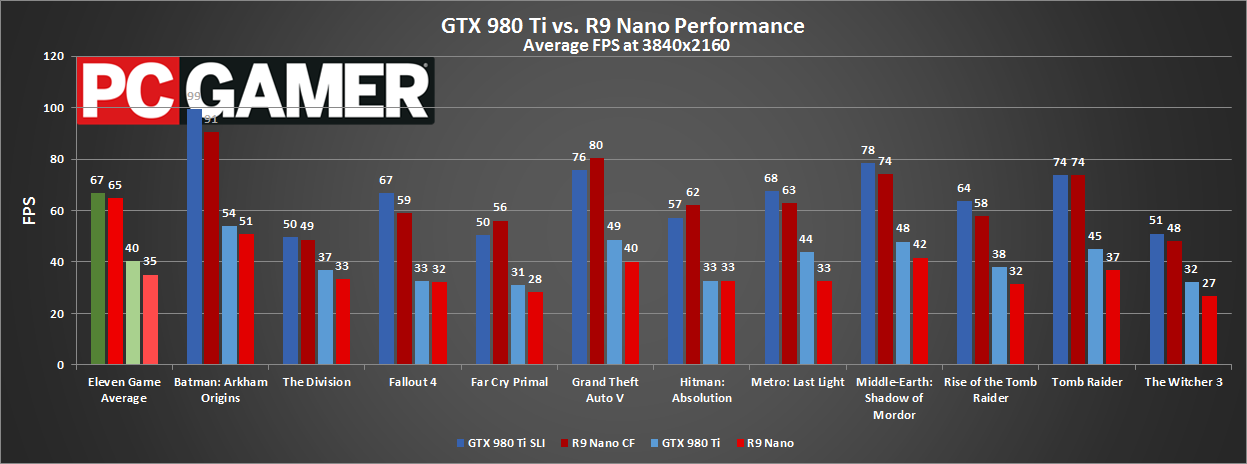
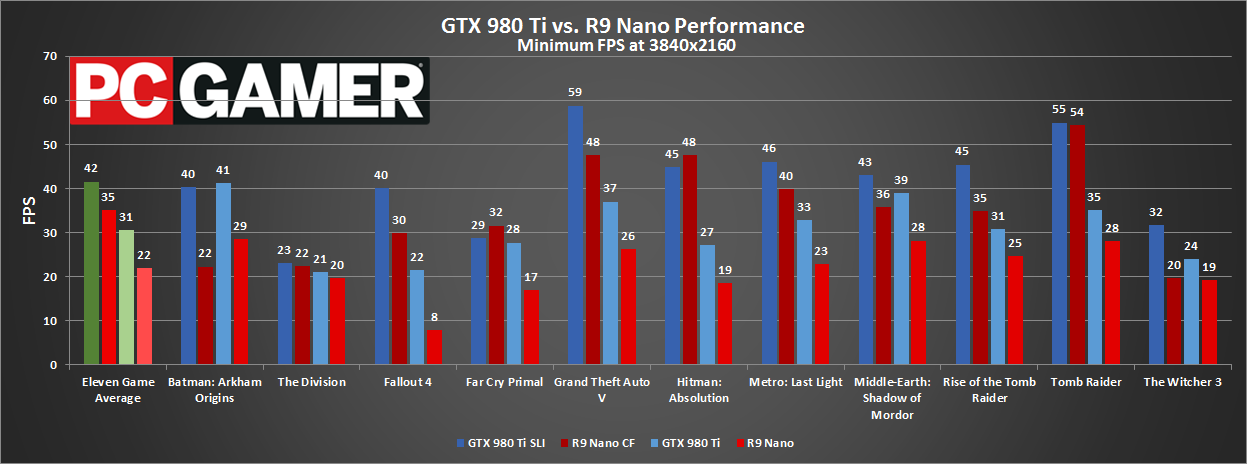
Starting with our 4K testing, dual Nano GPUs can come quite close to matching dual GTX 980 Ti, and even manage a few wins (in Far Cry Primal, GTAV, and Hitman: Absolution). Considering there's a power draw advantage for AMD here (350W vs. 500W TDP), not to mention the memory disadvantage (4GB vs. 6GB per GPU), if we're talking about AMD's $1000 pair of cards and Nvidia's $1200 pair of cards, both are great performers. A single 980 Ti is 15 percent faster than a single Nano, but in SLI/CF the gap at 4K is only three percent on average. This is due to overall much better scaling on AMD: CrossFire improves AMD's performance by 85 percent, but SLI only increases the Nvidia performance by 66 percent.
Of course from a gaming perspective, paying $1500 for the same performance is a different matter. There's also the matter of the minimum frame rates, where the 4GB VRAM takes its toll. This time, a single 980 Ti has 40 percent higher minimum frame rates on average, though in dual-GPU configurations the gap narrows to 19 percent. Interestingly, despite having less VRAM, 4K has been one of AMD's strong positions.
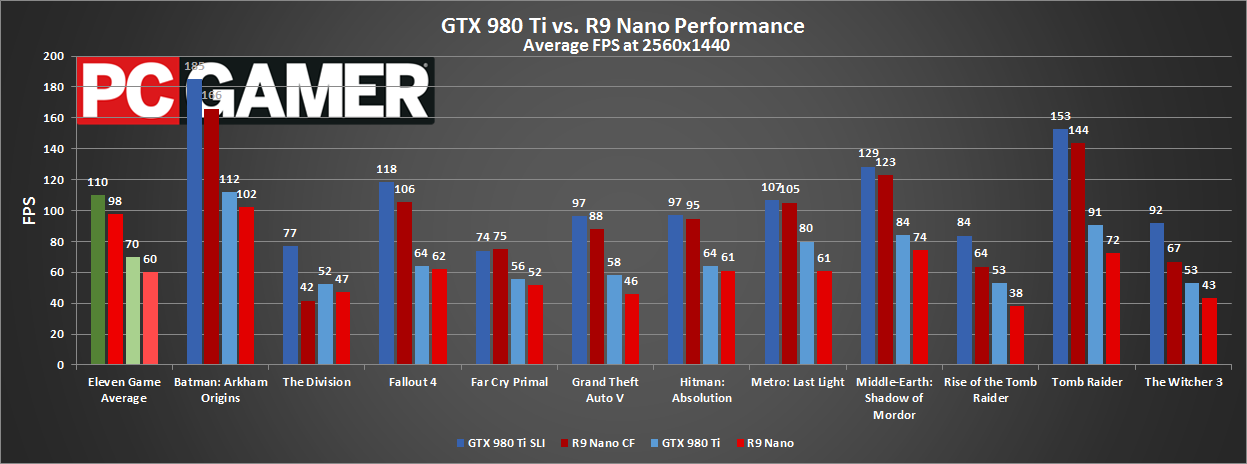
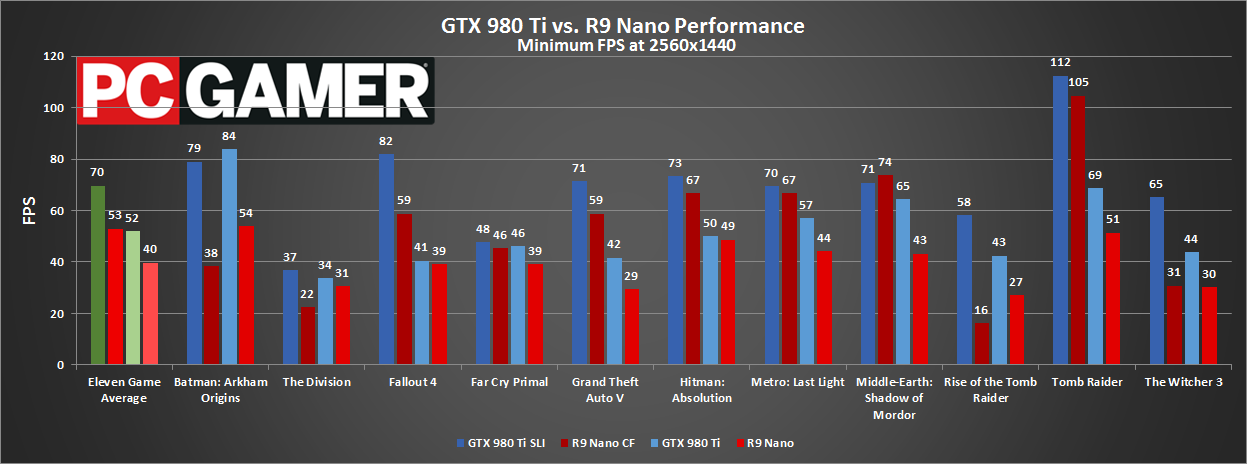
Dropping to 2560x1440, things are more in favor of Nvidia overall. All of our test games are running above 60 fps on the 980 Ti SLI setup, and AMD comes close, though they fall well short in The Division—where CrossFire actually reduced performance for R9 Nano (which wasn't the case at 4K). Considering 4K isn't really all that common a use case, this is arguably a more important battleground. Average frame rates favor Nvidia's GPU by around 15 percent overall, while minimum frame rates are over 30 percent higher.
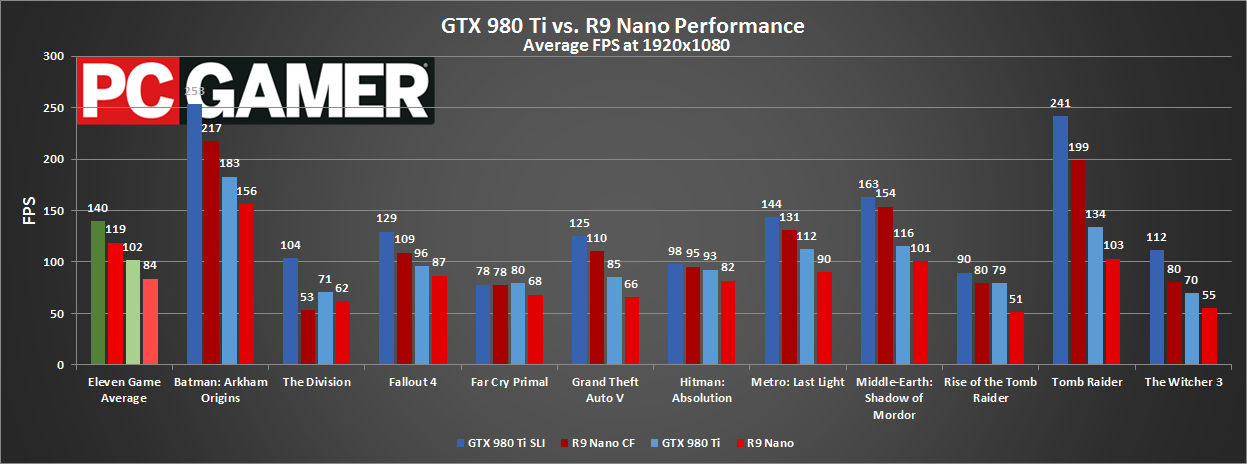
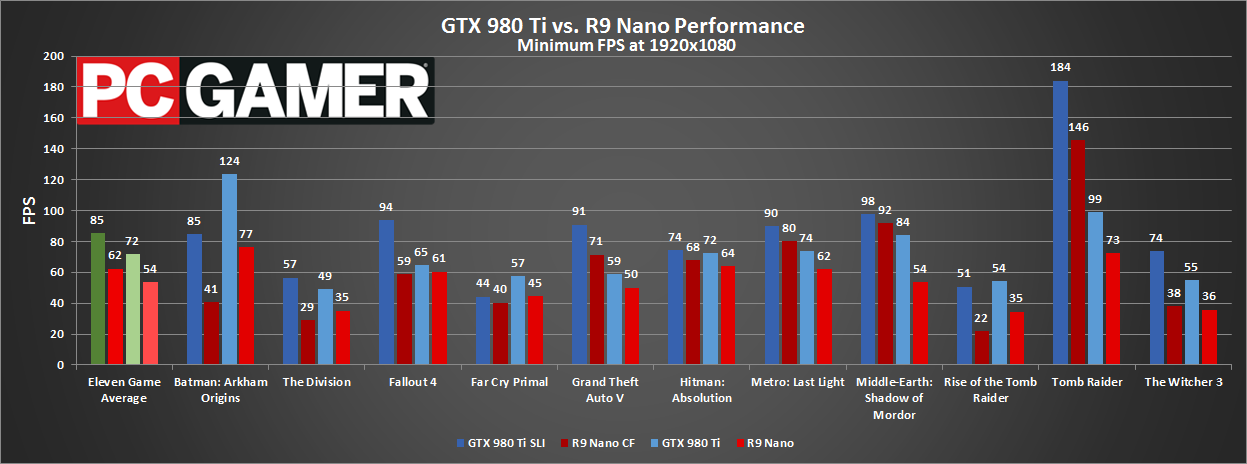
1080p gaming, even at essentially maximum quality, really isn't the target market of any of the graphics card setups here, though in general the results are pretty similar to 1440p.
As a reprise of what we saw last fall, this should all be pretty familiar territory. AMD's R9 Nano is far more attractive now at $500 than the original $650, and it's a sweet little card—though you do need to plan around the open air cooler if you're using a small case, as venting heat into the chassis can be problematic. The Pro Duo does solve the issue of an open air cooler, but it's also a much larger card and you now need a place for the radiator—not really a problem in any decent ATX case, naturally, but fitting it into a smaller can would require more planning and carefully selecting components. What the Pro Duo doesn't do is cater to gamers in any way that we'd recommend going out and buying one—content developers, maybe, but not pure gamers.
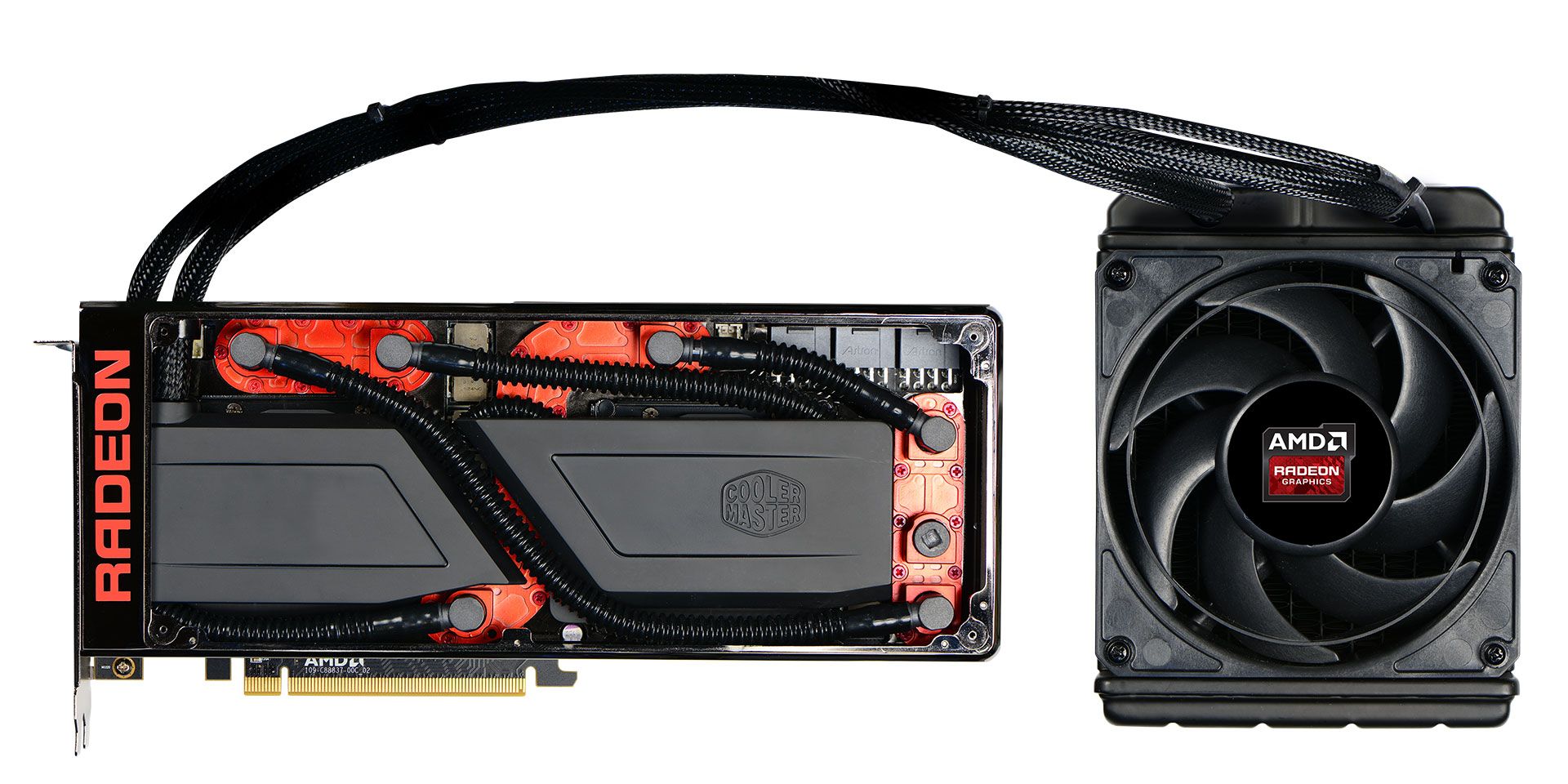
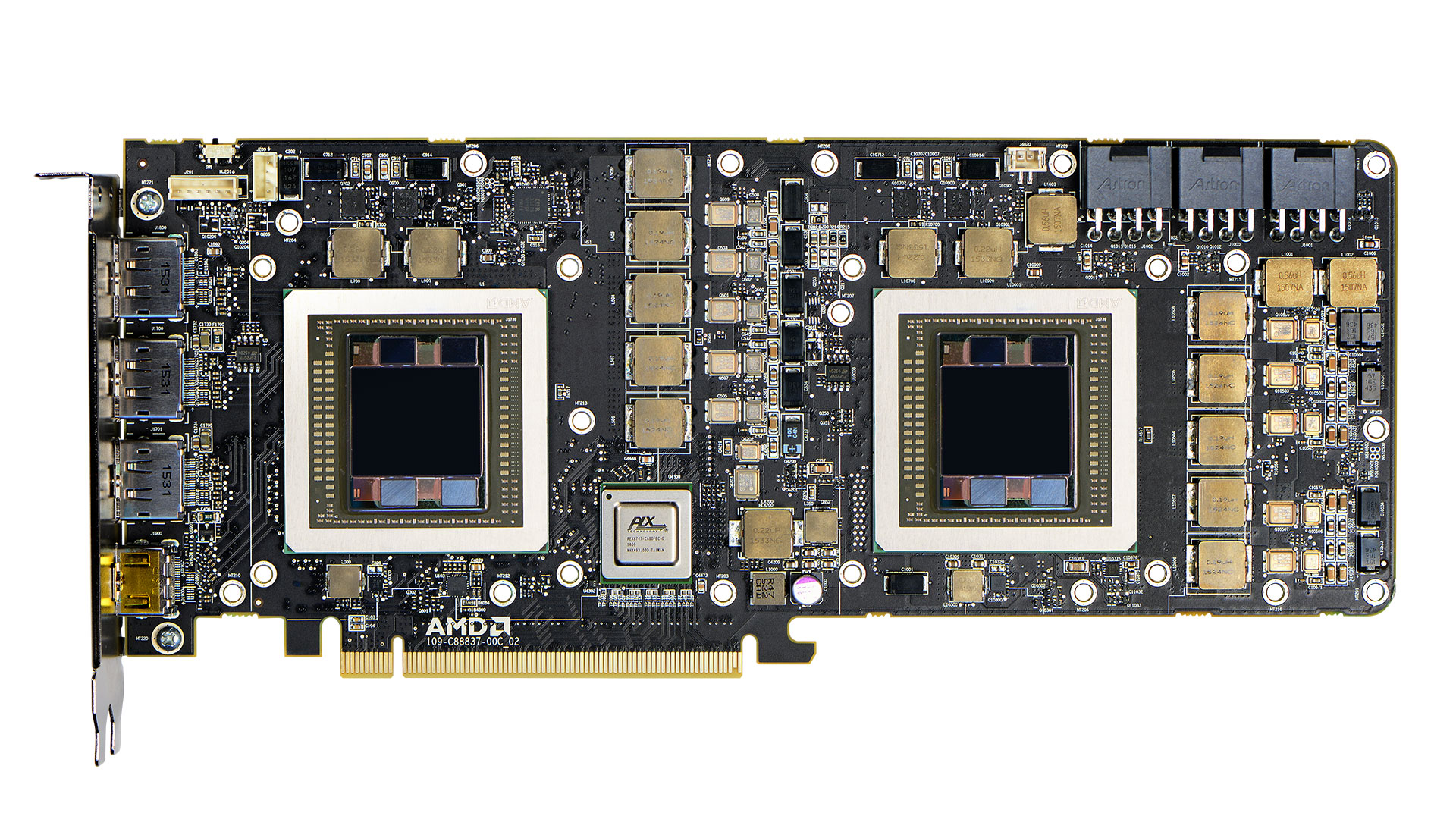
That's a shame, because as an engineering feat, the Radeon Pro Duo looks freaking awesome. Check out the compact cooling solution, and it's hard not to be impressed; the HBM modules allow for a much smaller area than previous dual-GPU cards. It's too bad AMD didn't get this out the door earlier, when it could have made more of a splash. It's a graphical tour de force for AMD's Fiji, the most potent implementation we're going to see, but sadly, it's too late by half.
The Pro Duo isn't bad, but unless you absolutely have to buy a new graphics card today—and you're interested in LiquidVR, DX12, VR, and/or content creation—there's no sense in rushing out to buy one. AMD may or may not release a high-end Polaris part in June, but Nvidia certainly has plans, if rumors are correct. Worst case, you can still get two R9 Nano cards—or even a pair of R9 Fury or R9 Fury X—for less money. That leaves the Pro Duo as a sweet looking card, but one that will likely have a very short shelf life.
Jarred's love of computers dates back to the dark ages when his dad brought home a DOS 2.3 PC and he left his C-64 behind. He eventually built his first custom PC in 1990 with a 286 12MHz, only to discover it was already woefully outdated when Wing Commander was released a few months later. He holds a BS in Computer Science from Brigham Young University and has been working as a tech journalist since 2004, writing for AnandTech, Maximum PC, and PC Gamer. From the first S3 Virge '3D decelerators' to today's GPUs, Jarred keeps up with all the latest graphics trends and is the one to ask about game performance.

